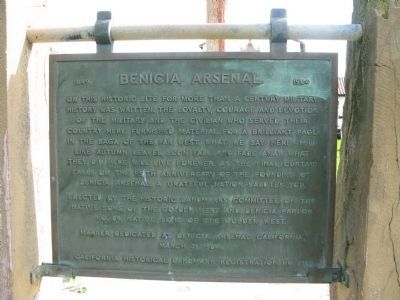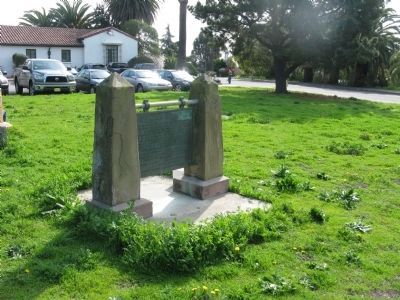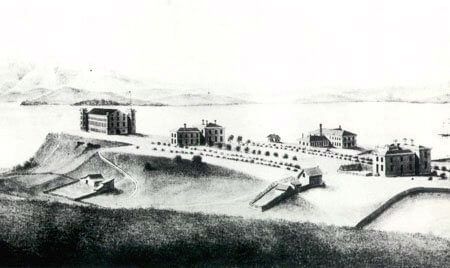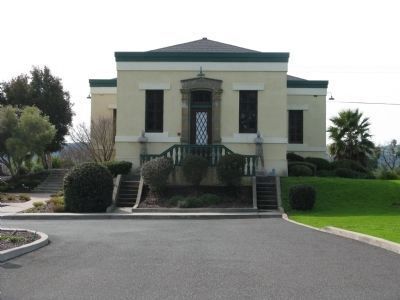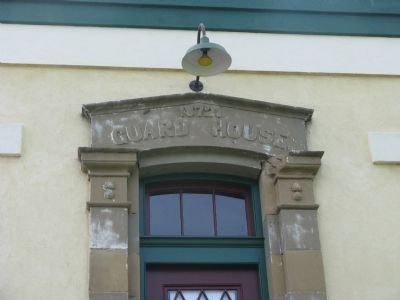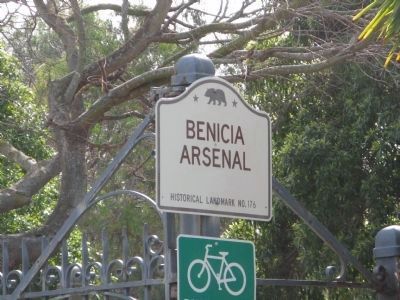Benicia in Solano County, California — The American West (Pacific Coastal)
1849 - Benicia Arsenal – 1964
On this historic site for more than a century military history was written. The loyalty, courage, and devotion of the military and the civilian who served their country here furnished material for a brilliant page in the saga of the far west. What we say here – will like autumn leaves, soon fall and fade away. What they did here will live forever. As the final curtain falls on the 115th anniversary of the founding of Benicia Arsenal, a grateful nation salutes you.
Erected 1964 by Historic Landmarks Committee of the Native Sons of the Golden West and Benicia Parlor No. 89 Native Sons of the Golden West. (Marker Number 176.)
Topics and series. This historical marker is listed in this topic list: Military. In addition, it is included in the California Historical Landmarks, and the Native Sons/Daughters of the Golden West series lists.
Location. 38° 2.858′ N, 122° 8.361′ W. Marker is in Benicia, California, in Solano County. Marker is at the intersection of Jefferson Street and Adams Street, on the right when traveling east on Jefferson Street. Marker is located at the main gate of the port area. Touch for map. Marker is in this post office area: Benicia CA 94510, United States of America. Touch for directions.
Other nearby markers. At least 8 other markers are within one mile of this marker, measured as the crow flies. Gen. Quandt Lane (approx. 0.3 miles away); Commandant's Home (approx. 0.3 miles away); Clock Tower (approx. 0.4 miles away); 1854 – Saint Paul’s Episcopal Church – 1954 (approx. one mile away); Saint Paul's Episcopal Church (approx. one mile away); World War I Memorial (approx. one mile away); Site of Benicia Seminary (approx. one mile away); First Masonic Hall Built in California (approx. one mile away). Touch for a list and map of all markers in Benicia.
Regarding 1849 - Benicia Arsenal – 1964. This site was designated California Historical Landmark No. 176 on March 6, 1935.
Statement of Significance:
Captain Charles P. Stone, with 21 enlisted men, established Benicia Arsenal as an ordnance depot in August 1851. The first building, a small wooden powder magazine, was erected in September 1851. Between 1853 and 1863, Congress authorized $550,000 to be spent on the establishment, and some 15 stone and frame buildings were constructed. The arsenal was first called 'California Ordnance Depot,' then 'Benicia Arsenal Depot,' and finally, in the spring of 1852, 'Benicia Arsenal.' It played an important role in crises such as the Indian wars. Some of its original buildings are in use today. Descendants of the men who established Benicia Arsenal are still living in Benicia and other parts of California.
This site was placed on the National Register of Historic Places on November 7, 1976.
Also see . . .
1. The Posts at Benicia. Military Museums website entry (Submitted on February 20, 2009, by Syd Whittle of Mesa, Arizona.)
2. Benicia Arsenal. National Parks Service entry (Submitted on February 20, 2009, by Syd Whittle of Mesa, Arizona.)
3. History of Benicia. The Benicia Chamber of Commerce website entry:
Benicia Arsenal: From 1849 to 1964, the Benicia Arsenal housed millions of pounds of ammunition and explosives. Now it's home to some of the Bay Area's successful artists and craftpersons. In 1849 Benicia's founders gave 345 acres of land near the Carquinez Strait to the Army. In 1850 the Arsenal became the first ordinance supply depot on the West Coast, supplying equipment and munitions for conflicts from the Civil War through Korean War. The federal government decided to close the base in 1960 and in 1964 the Army turned the Arsenal over to the City of Benicia. The Arsenal became the hub of Benicia industry. Some of its large warehouses were used to store goods and some were converted to machine shops (Submitted on February 20, 2009, by Syd Whittle of Mesa, Arizona.)
4. Benecia Historical Museum. Museum website homepage (Submitted on June 13, 2022, by Larry Gertner of New York, New York.)
Additional commentary.
1. The Military Role
For over 100 years the military was a dominate presence in Benicia, strongly influencing the economic and social life of the community. Established in 1851, the Arsenal stored powder and weapons and furnished arms and material to survey parties and interior forts. It dispatched Western troops to the Civil War and Spanish-American War, and served as Pacific Coast Ordinance Headquarters during World Wars I and II and the Korean conflict. Activities gradually declined until the government finally ordered the closure of the Arsenal in March 1964.
Source: Historic Benicia Walking Tour Brochure.
— Submitted February 20, 2009, by Syd Whittle of Mesa, Arizona.
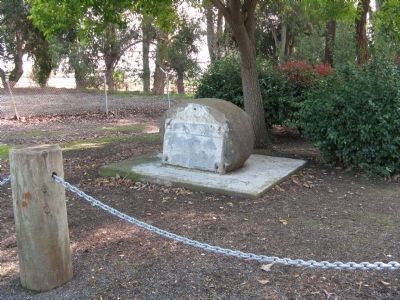
Photographed By Syd Whittle, February 20, 2009
4. The Benicia Barracks
Marker base is located at 711 Hillcrest Avenue. Marker is missing.
Click for more information.
Click for more information.
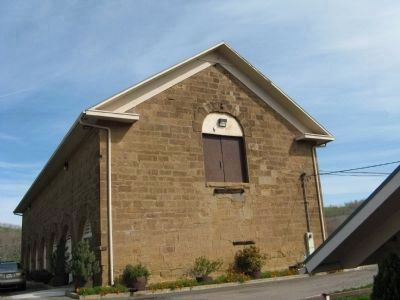
Photographed By Syd Whittle, February 20, 2009
5. Camel Barns
The camel barns served to house a herd of camels to be used in the western deserts.
Click for more information.
Click for more information.
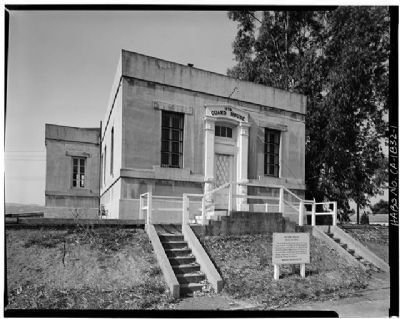
8. The Guard House 1872 - The Third for the Post
Marker (seen in photo) Inscription:
Guard House
Built in 1872
This is the third guard house built on the former arsenal grounds. It is pointed out primarily because the first guard house, built in 1852, was the setting of the trial of Second Lieutenant Ulysses S. Grant later President of the United States, charged with a minor infraction of military regulations. The rear portion of the building housed the military fire equipment.
[Marker placed by Benicia Industries, Inc]
Photo Source: Library of Congress
Historic American Buildings Survey
Built in 1872
[Marker placed by Benicia Industries, Inc]
Photo Source: Library of Congress
Historic American Buildings Survey
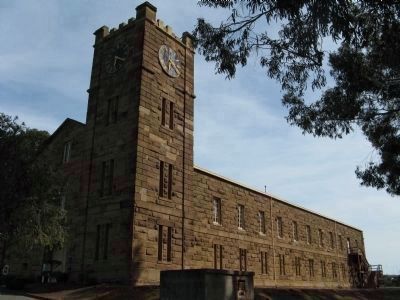
Photographed By Syd Whittle, February 20, 2009
9. The Clock Tower
The first clock tower had two towers, but when rebuilt after an explosion, only one tower was replaced.
Click for more information.
Click for more information.
Credits. This page was last revised on October 18, 2023. It was originally submitted on February 20, 2009, by Syd Whittle of Mesa, Arizona. This page has been viewed 2,825 times since then and 27 times this year. Photos: 1, 2. submitted on February 20, 2009, by Syd Whittle of Mesa, Arizona. 3. submitted on June 13, 2022, by Larry Gertner of New York, New York. 4. submitted on February 20, 2009, by Syd Whittle of Mesa, Arizona. 5. submitted on February 21, 2009, by Syd Whittle of Mesa, Arizona. 6, 7. submitted on February 20, 2009, by Syd Whittle of Mesa, Arizona. 8. submitted on April 5, 2009, by Syd Whittle of Mesa, Arizona. 9, 10. submitted on February 20, 2009, by Syd Whittle of Mesa, Arizona.
